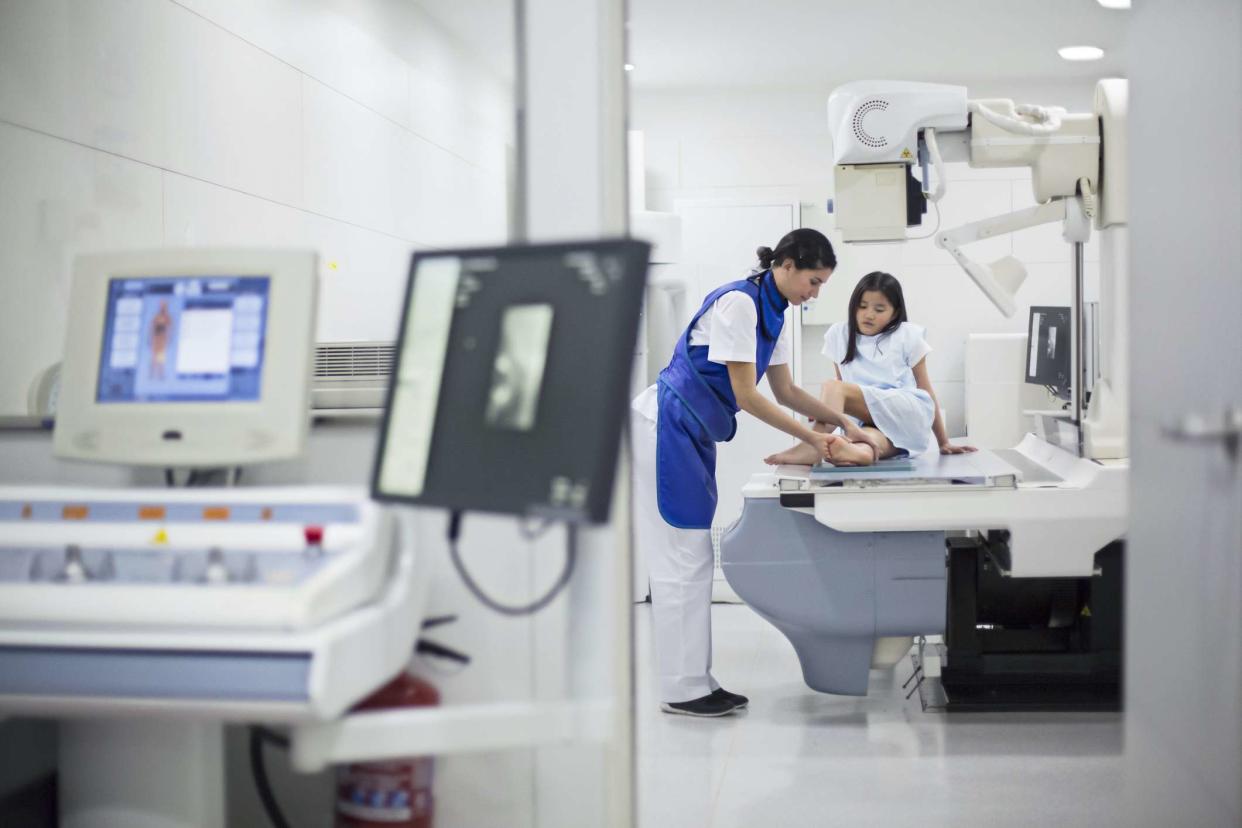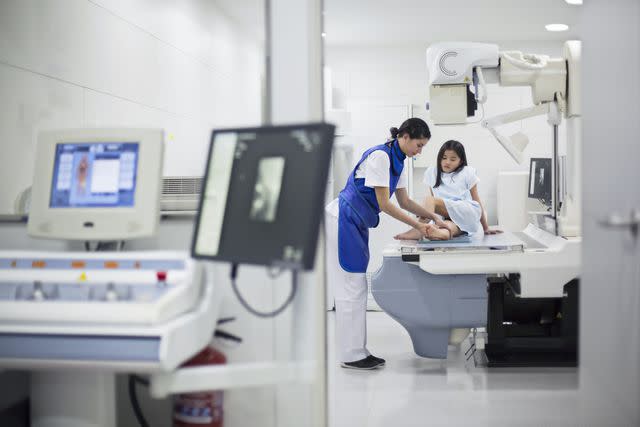What Is Ewing Sarcoma?

xavierarnau / Getty Images
Medically reviewed by Daniel Combs, MD
Ewing sarcoma is the second most common bone cancer in children, teens, and young adults, but is still fairly rare. It is only diagnosed about 250 times a year in the United States. Sarcoma is a cancer that starts in the bones or in nearby soft tissue (such as tendons, muscles, and connective tissues). It can also spread to other parts of the body and organs.
This article will explore the types of Ewing sarcoma, its symptoms, diagnosis, treatment, and prognosis.

xavierarnau / Getty Images
Types of Ewing Sarcoma
There are two types of Ewing sarcoma. Each type grows in either the bones or soft tissue, as follows:
Bone: Typically occurs in the leg, pelvis, ribs, arm, or spine
Soft tissue: Usually occurs in the thigh, pelvis, spine, chest wall, or foot
Ewing sarcoma used to be known as extraosseous Ewing sarcoma or Askin tumor, terms not used anymore.
Other undifferentiated small round cell tumors are treated like Ewing sarcoma but are not considered Ewing sarcoma.
Ewing Sarcoma Symptoms
Signs and symptoms of Ewing sarcoma can include:
Lump in the arms, legs, chest, or pelvis; it may feel soft and warm
Pain and/or swelling near the lump
Unexplained fever
Unexplained broken bone
Any of these symptoms should be reported to your child’s healthcare provider immediately.
Causes
While there is no definitive cause for Ewing sarcoma, some factors may increase its risk. Having one or more risk factors does not mean you will develop cancer, and having no risk factors doesn’t necessarily mean you won’t develop the cancer. They are merely things to keep in mind.
Factors increasing the incidence of Ewing sarcoma include:
Genetic changes: These occur for no known reason and are not hereditary; many Ewing sarcomas have a chromosomal translocation (swapped pieces of chromosome in a cell). This most often happens between chromosomes 11 and 22, though it has also been seen between chromosomes 21 and 22, 7 and 22, and 17 and 22.
Age: While this cancer can occur at any age, it’s most often diagnosed between the ages of 10 and 20.
Sex: Ewing sarcoma is more common in boys than girls. (Note that when health authorities are cited, the terms for sex or gender from the source are used.)
Ewing sarcoma is more frequently diagnosed in White individuals rather than in other racial groups. It is rare in Black individuals in the United States.
Diagnosis
Many different tests may be used to help diagnose Ewing sarcoma. The tests are chosen based on symptoms, the kind of cancer suspected, the individual’s age and their overall health, and other tests they might have had.
A physical exam and complete medical history are conducted. Tests that may be ordered include:
Blood tests: A complete blood count (CBC) and liver and kidney function tests are often ordered. These tests are not sufficient to make a diagnosis but can aid in a diagnosis.
X-ray: Can help find bone tumors
Computed tomography scan (CT scan)
Positron-emission tomography (PET) scan
The imaging tests like X-ray, CT scan, MRI, PET scan, and bone scans locate tumors and can detect if the cancer has spread and to where.
If a tumor is found, a biopsy (sample of the tumor) is taken and examined in the lab to find out what kind of cells are in the tumor.
Other tests performed on the biopsied material may include cytogenetic testing or biomarker testing. These tests can help determine which genetic changes are in the tumor and the characteristics of the cells that make up the tumor, which can help guide treatment.
Treatment
A pediatric oncologist (a cancer specialist for children) and a multidisciplinary team made up of a variety of professionals should be integral to treating Ewing sarcoma.
Treatment plans can vary based on individual circumstances, but common treatments include:
Chemotherapy: This is usually the first treatment given, followed by either surgery or radiation therapy to get rid of any remaining cancer. Drugs include Cytoxan or Neosar (cyclophosphamide), Adriamycin (doxorubicin), Toposar (etoposide), Ifex (ifosfamide), and Oncovin (vincristine).
Surgery: The tumor and some surrounding tissue are removed, usually after chemotherapy. This may not cause a loss of function, but in some cases, bone grafts or a prosthesis and rehabilitation will be needed.
Radiation therapy
Clinical trials: These research studies explore new treatments or protocols to see if they are effective for Ewing sarcoma. Treatments may include bone marrow transplantation/stem cell transplantation, immunotherapy, or targeted therapy
More than 60% of children and teens with cancer are in a clinical trial for their treatment. This is because cancer in children and young adults is fairly rare, and so there are no standardized protocols based on large-scale studies as there are for adults.
In most cases, surgery to remove the tumor will not result in disability. For arms and legs, limb-sparing surgery keeps the limb intact. It may use bone grafts or an internal prosthesis (such as a rod). Amputation is rarely needed.
Prognosis
Recurrence is most likely within the first two years after treatment is finished, but it's not uncommon for later recurrences to occur.
The overall five-year survival rate for Ewing sarcoma for those under age 15 is 78%. It is 64% for those 15 to 19 years old. Overall, the five-year survival rate for Ewing sarcoma is 63%.
Based on the spread of the cancer, the five-year survival rate is:
Localized (the tumor is only where the tumor began): 82%
Regional (spread nearby): 71%
Distant (metastasized to other areas or parts of the body): 39%
Five-year survival rates look at populations and do not predict an individual's prognosis or reflect any recent treatment developments. It's important to remember that each person is different, with a variety of individual factors to take into account. Talk with your treatment team about your or your child's situation and prognosis.
Coping
Cancer and its treatment can be challenging for anyone to deal with, especially children, teens, and the larger family unit. The physical and emotional side effects from treatment can be a lot to handle, especially if there are physical changes like removing a limb or changes in functioning. It’s important to put to gather a support team.
Talk with your or your child's treatment team about finding support groups, therapists, advocates, and anyone else who can help make treatment less stressful. Let friends and other family know what they can do to help, whether it’s with chores around the house, raising money to help with medical expenses, or simply being a shoulder to lean on.
Summary
Ewing sarcoma is a rare cancer most often diagnosed in children and teens, although it can occur at any age. It is a cancer of the bones or the surrounding soft tissue. It's thought to be associated with chromosomal changes but is not hereditary.
There are a variety of treatments for it, including chemotherapy, surgery, and radiation therapy. Talk with your treatment team to learn more about your or your child's diagnosis and the characteristics of the cancer. This will keep you informed and help you make informed decisions regarding care.

